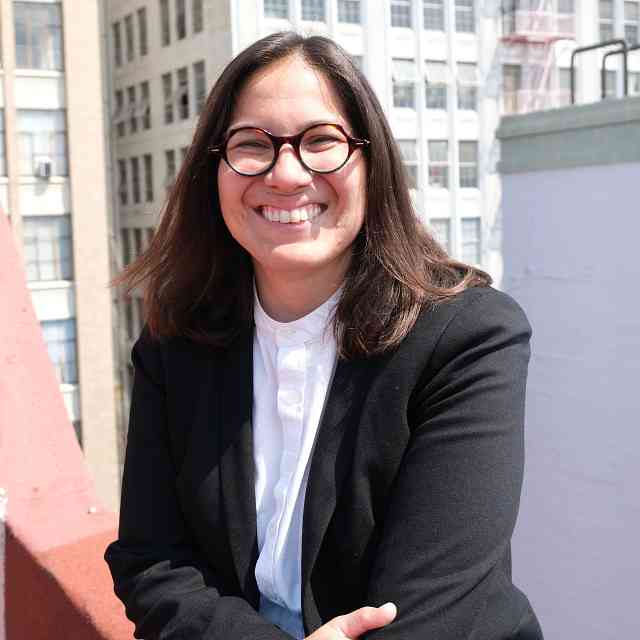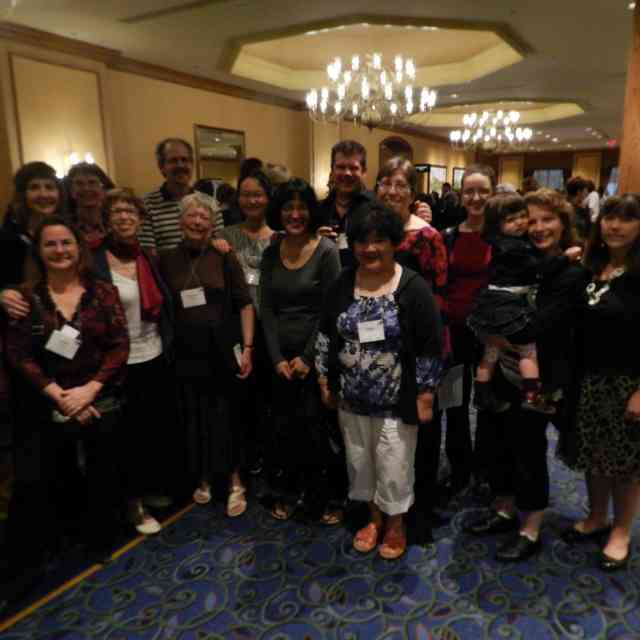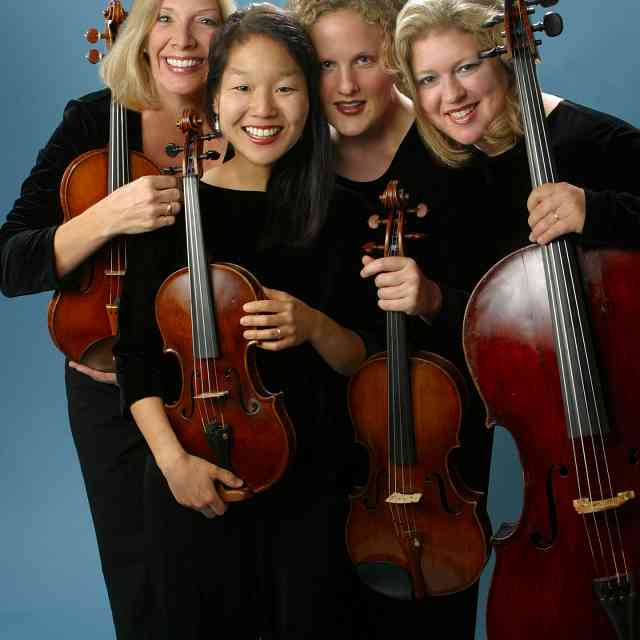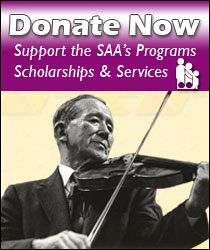Since our Suzuki Conference in Louisville, Kentucky in March 2024, I’ve noticed a trending topic at Chapter Affiliate meetings, Suzuki Training Committee meetings, and as we plan for the 2025 Leadership Summit in Atlanta, Georgia. There is a lot of thought being given to generations. How do we pass the torch from one generation to the next? How will the Suzuki philosophy continue to grow and develop in generations that never met its originator? Will we see the potency of the Suzuki Method diluted by modern demands, a too-casual approach, endless distractions, and over-scheduled lives?
I remember the opening of the Leadership Retreat in May 2010 in Deerfield, Ohio. I think this was the first Leadership Retreat I ever attended, and I was nervous as I did not know many of the teachers in attendance very well. We played a “getting to know you” game to kick off the weekend. Part of the game involved going around the room and meeting people that met certain criteria: “Did you ever meet Dr. Suzuki?” “Have you traveled to Japan?” As these questions echoed around the room, they gave me immediate pause. I realized that at a time in the near future, there wouldn’t be any teachers who have met Dr. Suzuki or studied with him in Japan. This future time is now drawing near.
Though I have been teaching the violin to children for over twenty years, I often reflect upon the earliest years of my Suzuki journey. There were many challenges. Beyond the various training requirements and implementation complexities, I also felt like an outsider. Having grown up in a “traditional” musical culture, I was faced with learning a new and expansive repertoire, wrapping my brain around a philosophy that is as complex as it is simple, and entering a community that had not only well-established leaders, but also a younger generation who may have known each other most of their lives. This was a very different system. I wondered, “Will I fit in here? Is there a place for me?”
Adding to these early difficulties, it quickly became clear to me that I possessed a complete lack of knowledge of Suzuki idioms, jargon, and in particular, history. As a new Suzuki teacher, I knew there was much to learn beyond philosophy and pedagogy. What is Matsumoto? Who was John Kendall? What is the source of my trainer’s information? What is an Institute? What is a play down? I knew I was stepping into something immense; it felt like learning another language. As I attempted to learn more about the Suzuki Method, I struggled to develop a sense of chronology and had difficulty making connections between the people, places, and ideas that I was hearing about. Therefore, my understanding of the development of the Suzuki Method was limited to a potpourri of stories and memories crammed into a few key periods.
Suzuki in His Own Words
Unsatisfied with my fragmented understanding of the past, I started to study the life and work of Dr. Suzuki in earnest. I began my quest by reading the works of Dr. Suzuki, and here is what I discovered. Four books authored by Dr. Suzuki have been translated into English. These works primarily serve to relay his educational philosophy and chronicle his life experiences. The dates of copyright for Japanese and English versions are given after each title: Man and Talent (1958), Nurtured by Love (1969, rev. ed. 1983), Ability Development from Age Zero (1981), and Talent Education for Young Children (1986). In addition to these sources, several collections of Suzuki’s essays and speeches are available in publication: Where Love is Deep (Selden, 1982), Lectures on Musical Instruction (Suzuki, 1986), and Shinichi Suzuki: His Speeches and Essays (Ability Development, 1989).
Dr. Suzuki’s beliefs concerning the purpose and value of music education, and indeed much of his educational philosophy, are revealed through his aphorisms. These short sayings embody a personal truth or an astute observation. The resulting tone is both clear and direct. They reflect his belief that the purpose of education in music should be the cultivation of artistic appreciation to develop character and citizenship. In this light, Dr. Suzuki made clear that the value of music exists in its capacity to enrich the human experience. Describing the unique value of music to the human experience, Suzuki stated: “For the sake of our children let us educate them from the cradle to have a noble mind, a high sense of values and splendid ability. At our institute we use violin playing to develop these qualities in children” (Suzuki 1983, 17).
For Dr. Suzuki, nonmusical ideals are more important than musical objectives. The process of learning to play an instrument through patience, endurance, and discipline serves as a vehicle for developing citizenship and for extending the child’s abilities in other areas. The following three quotes illustrate this:
I just want to make good citizens. If a child hears good music from the day of his birth, and learns to play it himself, he develops sensitivity, discipline, and endurance. He gets a beautiful heart. If nations cooperate in raising good children, perhaps there won’t be any war. (Suzuki 1983, 105)
The purpose of Talent Education is to train children, not to be professional musicians but to be fine musicians and to show high ability in any other field they enter, (Suzuki 1983, 79)
The final objective of Talent Education is to cultivate artistic appreciation in a child, not to make a musician out of every child we teach. It is a movement started by myself and carried on by parents who want to bring up their children to have a refined human character. (Suzuki 1960, 62)
Dr. Suzuki’s central tenet is that each person can develop the “talent” of playing a musical instrument; all children are born with profound potential ability and this ability must be nurtured in the correct environment. He explained much of his philosophy and ideas concerning the value of music education through references to his own experience, thereby making Nurtured by Love autobiographical. Through his aphorisms, Suzuki expresses his belief in teaching, through music, the human virtues of cooperation, harmony, endurance, kindness, idealism, charity, modesty, humility, understanding, dedication, patience, courtesy, love, nobility of purpose, nobility of the human spirit, the cultivation of beauty, teaching as a joy, and faith in children’s ability.
“Meeting” Suzuki
As Dr. Suzuki’s ideas spread across the United States, his work touched many lives. Beyond the primary sources, many works have been composed addressing the influence that Dr. Suzuki has had in instrumental pedagogy, philosophy of music education, or an author’s life. I made it a goal to read everything written about Dr. Suzuki and his method. Searching books, articles, dissertations, films, websites, and bibliographies, I encountered a staggering volume of work; there was so much to learn. Most recently, in 2022, Eri Hotta published Suzuki: The Man and His Dream to Teach the Children of the World, offering a comprehensive exploration of Dr. Suzuki’s life and philosophy and adding nuanced perspectives to existing Suzuki literature. Hotta’s work delves deeply into both Suzuki’s pedagogical innovations and the broader socio-cultural influences that shaped his vision. Through meticulous research and analysis, the book not only sheds new light on Suzuki’s impact on music education but also examines his legacy within the evolving landscape of educational methodologies worldwide. This contribution broadens readers’ understanding of Suzuki’s ideals and enduring influence on global music communities.
Through my studies, I’ve come to deeply appreciate our history. The history of the Suzuki Method and the philosophy that nurtures its continuance is a sophisticated and complex topic. The story of the Suzuki Method and the philosophy behind it is as intricate and interconnected as music itself.
Much like music, the rich saga of the Suzuki Method, with its events and people, periods and thoughts, all have antecedents and consequences: a series of small, interconnecting stories within an overarching narrative. Through these windows to the past, I began to form a geography of time and started sensing my own place within that map. In the words of Dr. Martin Luther King, Jr.: “We are not makers of history. We are made by history.” I discovered that learning our history is about gaining self-knowledge and knowledge of the present by getting to know the past.
Thanks to the work of Pat D’Ercole and others at the University of Wisconsin-Stevens Point, I’ve been able to view hours of video footage of Dr. Suzuki teaching in 1976 during his visit to the American Suzuki Institute. Although the picture and sound are limited by the technology of the era, the energy and spirit of Dr. Suzuki shine through. Here, one can witness firsthand Dr. Suzuki’s constant attention to tone production and observe his emphasis on repetition. These videos are available to view online by visiting the following link on the International Suzuki Association’s website: https://internationalsuzuki
.org/american-suzuki-inst-1976/
During this time, I began to ponder the idea that you can be mentored by someone you do not actually know or are unable to physically meet. Perhaps someone far beyond your own network, or someone who has passed away. By dedicating time to reading Dr. Suzuki’s biographies, autobiographies, speeches, and articles, I acquired valuable knowledge about his character, personality, actions, beliefs, and achievements. The insights gathered through this type of intense study can be applied toward achieving one’s own aspirations.
During the Virtual Leadership Retreat of 2009, I downloaded a filmed presentation by Dr. Sarah Hersh entitled “What We Can Learn from Dr. Suzuki’s Example.” As I watched this video, I found myself feeling completely mesmerized; I also felt a little sad. I wish I could have gone to Japan and studied with Dr. Suzuki. I know I would have gone in a heartbeat and stayed for years—but that wasn’t my time. It’s also troubling that for today’s teachers, there is no exact modern-day equivalent of being able to go to Japan and work directly with Dr. Suzuki. I sometimes wonder what it would have been like if I had been a teacher trainee in Japan, fortunate enough to sit at a table and drink tea and eat chocolates with Dr. Suzuki—or to be able to play for him. But that, in a way, is what history does: it allows one to occupy, emotionally and intellectually, the life of someone else in another age. One of the SAA’s values is honoring the legacy of Dr. Suzuki. In a future era of the SAA, when there are no longer teachers, parents, and students who met Dr. Suzuki, we will all be responsible for celebrating his life and work in new ways.
A Path Forward
In 1961, John Kendall, a founder of the American Suzuki movement, quoted Suzuki, stating, “We must learn more about the conditions in which early human growth takes place…we must investigate methods through which all children can develop their various talents” (Kendall 1961, 1). This quest continues today. The Suzuki Method was born in the twentieth century, and as we move further into the twenty-first century, new challenges will emerge. Suzuki teachers from every generation share the same journey, striving for excellence and the ability to unlock the potential of others through music. Countless new ideas will emerge, greater truths will surface, and we will arrive at better understandings fueled by achievements from other disciplines.The development of the Suzuki Method is more than a story from music history. Dr. Suzuki is more than just a name on our music books. Our journey is a sweeping tale, with a beginning, middle, and end…and a future. “Did you ever meet Dr. Suzuki?” No, but I want you to tell me about when you did.
Though I have never met Dr. Suzuki, I feel a deep and intuitive knowing of him. I feel privileged to have read his works and to have adopted the principles that guided his teaching and life. No matter which generation we belong to, we have all been mentored by Dr. Suzuki. I still wonder what it would have been like to meet him in person. But through books, videos, stories, and pictures, and by connecting his words with images of his joyful face, I believe it is indeed possible to know someone you can never meet.
References
Kendall, John (1961). Listen and Play. Evanston, Illinois: Summy-Birchard Company.
Suzuki, Shinichi (1958). Man and Talent: Search into the Unknown. Ann Arbor, MI: Shar Products.
Suzuki, Shinichi (1960). Outline of Talent Education method. Violins and Violinists, 21 (2), 59-62.
Suzuki, Shinichi (1969, rev. ed. 1983). Nurtured By Love: A New Approach to Education. Miami, FL: Summy-Birchard, Inc.
Suzuki, Shinichi (1981). Ability Development from Age Zero. Athens, OH: Ability Development Associates.
Suzuki, Shinichi (1982). Where Love is Deep: The Writings of Shinichi Suzuki. New Albany, IN: World-Wide Press.
Suzuki, Shinichi (1986). Talent Education and Young Children. Ann Arbor, MI: Shar Products.








